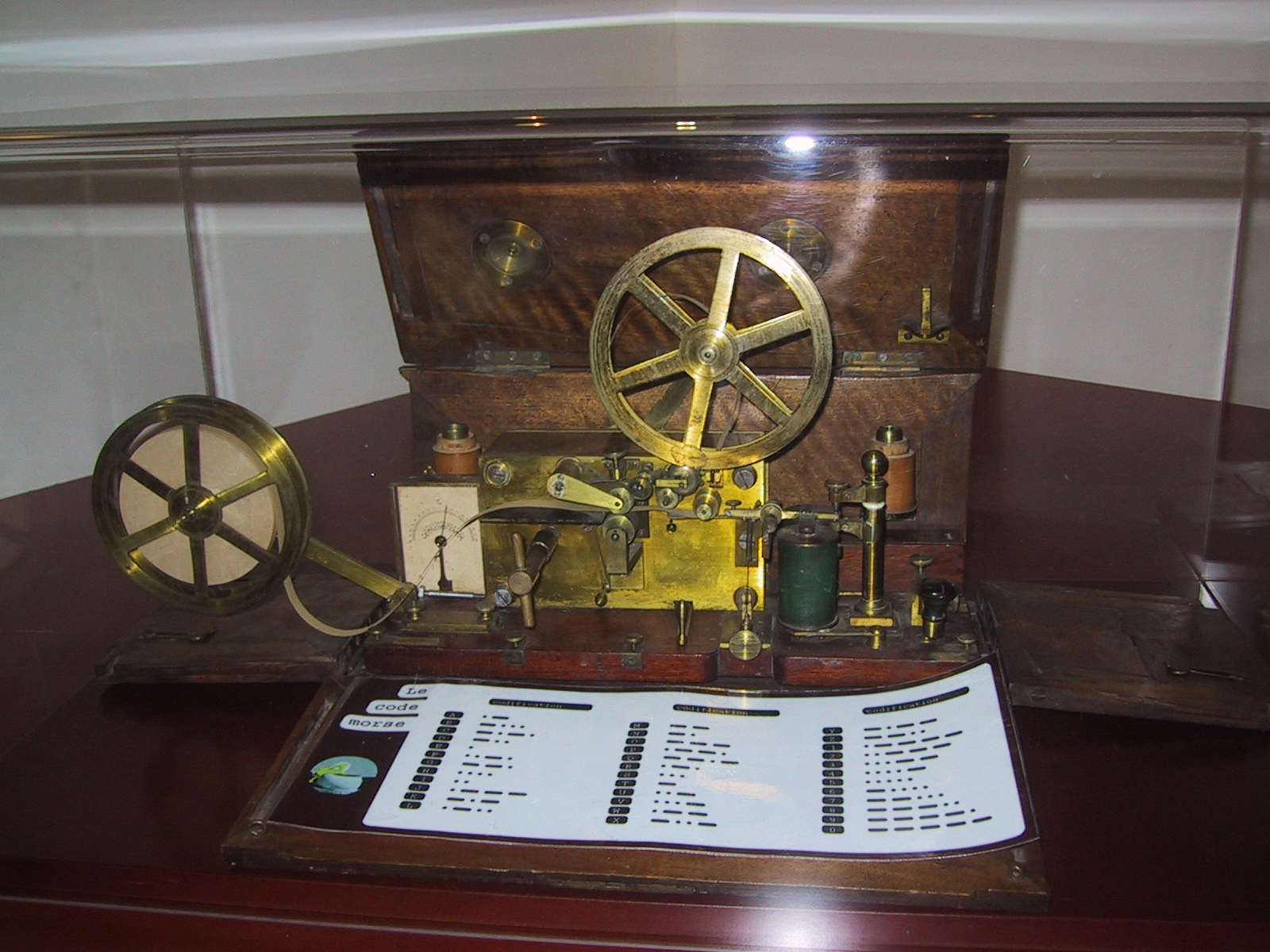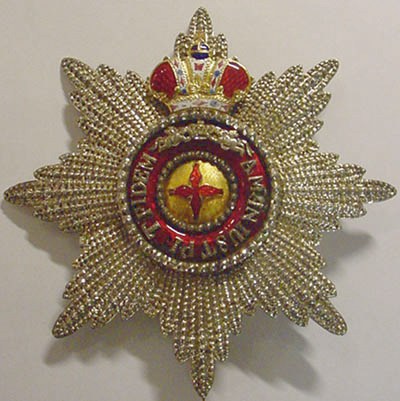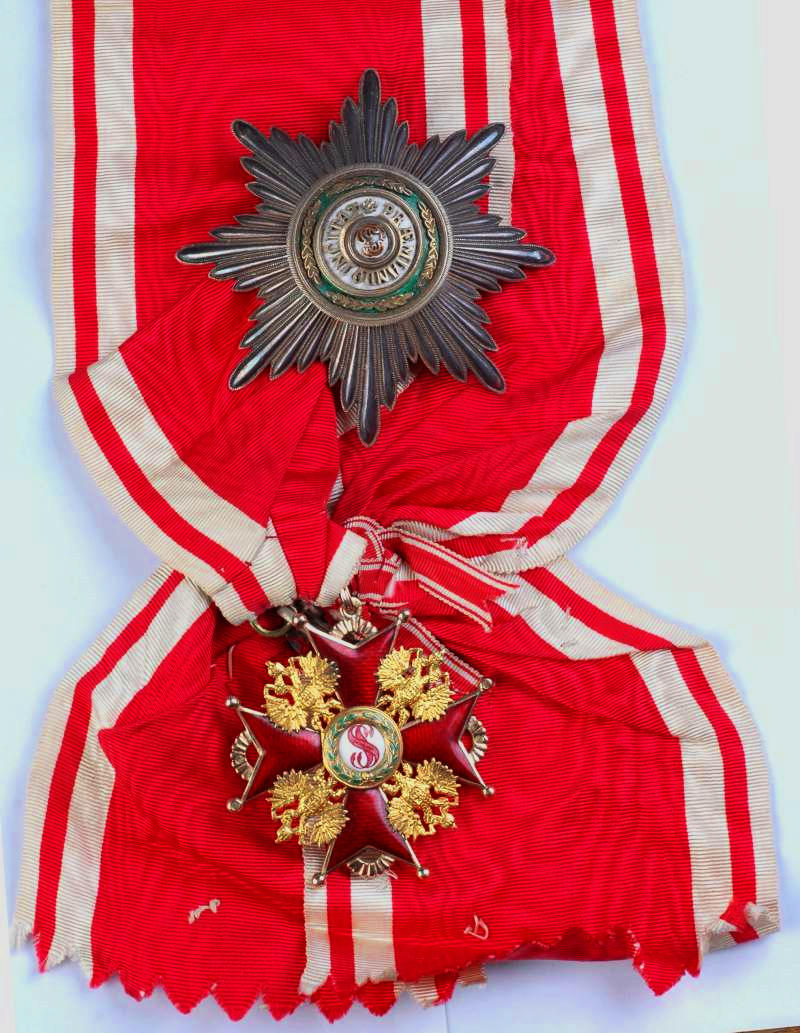|
Dmitry Petrovich Dokhturov
Dmitry Petrovich Dokhturov (25 May 1838 – 25 March 1905) was an Imperial Russian brigade, division and corps commander. He fought in the wars in the Caucasus and against the Ottoman Empire. Ranks * Poruchik (23 April 1859) * Stabskapitän (12 January 1861) * Captain (28 November 1861) * Rittmeister (17 April 1863) * Podpolkovnik ( lieutenant colonel) (13 September 1864) * Polkovnik (colonel) (27 March 1866) * Major general (14 September 1877) * Lieutenant general (30 August 1886) * General of the cavalry (6 December 1898) Awards * Order of Saint Stanislaus (House of Romanov), 3rd class, 1861 * Order of Saint Vladimir, 4th class, 1863 * Order of Saint Stanislaus (House of Romanov), 2nd class, 1868 * Order of Saint Anna, 2nd class, 1871 * Order of Saint Vladimir, 3rd class, 1874 * Gold Sword for Bravery, 1877 * Order of Saint Stanislaus (House of Romanov), 1st class, 1879 * Order of Saint Anna, 1st class, 1882 * Order of Saint Vladimir The Imperial Order of Saint P ... [...More Info...] [...Related Items...] OR: [Wikipedia] [Google] [Baidu] |
Tula Governorate
Tula Governorate () was an administrative-territorial unit ('' guberniya'') of the Russian Empire and the Russian SFSR. The governate existed from 1796 to 1929; its seat was in the city of Tula. It was divided into 12 districts. The main towns were Alexin, Bogoroditsk, Byelev, Chern, Epifan, Efremov, Kashira, Krapivna, Novosil, Odoyev, Tula, and Venev. Administrative division Ufa Governorate consisted of the following uyezds (administrative centres in parentheses): * Aleksinsky Uyezd ( Aleksin) * Belyovsky Uyezd ( Belyov) * Bogoroditsky Uyezd (Bogoroditsk) * Venyovsky Uyezd ( Venyov) * Yepifansky Uyezd ( Yepifan) * Yefremovsky Uyezd ( Yefremov) * Kashirsky Uyezd (Kashira) * Krapivensky Uyezd ( Krapivna) * Novosilsky Uyezd ( Novosil) * Odoyevsky Uyezd ( Odoyev) * Tulsky Uyezd ( Tula) * Chernsky Uyezd ( Chern) See also * Tula Oblast Tula Oblast () is a federal subjects of Russia, federal subject (an Oblasts of Russia, oblast) of Russia. It is geographicall ... [...More Info...] [...Related Items...] OR: [Wikipedia] [Google] [Baidu] |
1838 Births
Events January–March * January 10 – A fire destroys Lloyd's Coffee House and the Royal Exchange, London, Royal Exchange in London. * January 11 – At Morristown, New Jersey, Samuel Morse, Alfred Vail and Leonard Gale give the first public demonstration of Morse's new invention, the telegraph. * January 21 – The first known report about the Lowest temperature recorded on Earth, lowest temperature on Earth is made, indicating in Yakutsk. * January 23 – A 1838 Vrancea earthquake, 7.5 earthquake strikes the Romanian district of Vrancea County, Vrancea causing damage in Moldavia and Wallachia, killing 73 people. * February 6 – Boer explorer Piet Retief and 60 of his men are massacred by King Dingane kaSenzangakhona of the Zulu people, after Retief accepts an invitation to celebrate the signing of a treaty, and his men willingly disarm as a show of good faith. * February 17 – Weenen massacre: Zulu impis massacre about 532 Voortrekkers, Khoikhoi and Sotho people, ... [...More Info...] [...Related Items...] OR: [Wikipedia] [Google] [Baidu] |
Pavel Grigorievich Dukmasov
Pavel Grigorievich Dukmasov (6 November 1838 – 15 February 1911) was an Imperial Russian corps commander. He participated in the wars in the Caucasus and against the Ottoman Empire. He was promoted to Polkovnik (colonel) on 28 October 1866, and major general on 8 September 1874. Awards * Order of Saint Stanislaus (House of Romanov), 2nd class * Order of Saint Vladimir, 4th class, 1878 * Order of Saint Stanislaus (House of Romanov), 1st class, 1879 * Order of Saint Anna, 1st class, 1882 * Order of Saint Vladimir, 2nd class, 1885 * Order of Saint Vladimir The Imperial Order of Saint Prince Vladimir () was an Imperial Russian order established on by Empress Catherine the Great, Catherine II in memory of the deeds of Vladimir I, Prince of Kiev, Saint Vladimir, the Grand Prince and the Baptizer of ..., 1st class, 1906 External links Род Дукмасовых 1838 births 1911 deaths People of the Caucasian War Russian military personnel of the Russo-Turkish ... [...More Info...] [...Related Items...] OR: [Wikipedia] [Google] [Baidu] |
Vladimir Nikolayevich Filipov
Vladimir Nikolayevich Filipov (2 November 1838 – 12 May 1903) was an Imperial Russian lieutenant general, brigade, division and corps commander. He took part in the suppression of the uprising in Poland and in the war against the Ottoman Empire. He died in what is now Ukraine. Awards * Order of Saint Stanislaus (House of Romanov), 3rd class, 1863 * Order of Saint Anna, 3rd class, 1864 * Order of Saint Stanislaus (House of Romanov), 2nd class, 1869 * Order of Saint Anna, 2nd class, 1873 * Order of Saint George, 4th degree, 1877 * Gold Sword for Bravery, 1878 * Order of Saint Vladimir, 3rd class, 1878 * Order of Saint Stanislaus (House of Romanov), 1st class, 1887 * Order of Saint Anna, 1st class, 1890 * Order of Saint Vladimir The Imperial Order of Saint Prince Vladimir () was an Imperial Russian order established on by Empress Catherine the Great, Catherine II in memory of the deeds of Vladimir I, Prince of Kiev, Saint Vladimir, the Grand Prince and the Baptizer of ..., ... [...More Info...] [...Related Items...] OR: [Wikipedia] [Google] [Baidu] |
Order Of Saint Alexander Nevsky
The Imperial Order of Saint Alexander Nevsky was an order of chivalry of the Russian Empire first awarded on by Empress Catherine I of Russia. History The introduction of the Imperial Order of Saint Alexander Nevsky was envisioned by Emperor Peter I of Russia (r. 1682–1721) to reward military bravery in battle. However, he died before he could create the order. It was established by Empress Catherine I of Russia, in memory of the deeds of Saint Alexander Nevsky, patron Saint of the Russian capital of Saint Petersburg, for defending Russia against foreign invaders. The order was originally awarded to distinguished Russian citizens who had served their country with honor, mostly through political or military service. It was first awarded on the occasion of the wedding of Grand Duchess Anna Petrovna of Russia and Charles Frederick, Duke of Holstein-Gottorp in 1725. A dozen guests received the reward, and the order quickly fell far behind the Order of Saint Andrew and the O ... [...More Info...] [...Related Items...] OR: [Wikipedia] [Google] [Baidu] |
Order Of The White Eagle (Russian Empire)
The Imperial Order of the White Eagle () was an Russian Empire, Imperial Russian Order (honour), Order based on the Order of the White Eagle (Poland), Polish honor. Emperor Nicholas I of Russia established the award in 1831 as the ''Imperial and Royal Order of the White Eagle''. A recipient of the Order was granted the title ''Knight of the Imperial (and Royal) Order of the White Eagle''. Background The "white eagle" has been associated with Poland even prior to statehood; first appearing on the Coat of arms of Poland, Polish Coat of Arms in the 13th century. The original Order of the White Eagle (Poland), Order of the White Eagle () was reputedly established by Władysław I the Elbow-high, King Władysław I in 1325. There is no evidence of it being awarded, however, until 1705 under Augustus II the Strong, King of the Polish–Lithuanian Commonwealth. After the Third Partition of Poland in 1795, the Order of the White Eagle briefly disappeared along with the Polish monarchy. ... [...More Info...] [...Related Items...] OR: [Wikipedia] [Google] [Baidu] |
Gold Sword For Bravery
The Gold Sword for Bravery () was a Russian award for bravery. It was set up with two grades on 27 July 1720 by Peter the Great, reclassified as a public order in 1807 and abolished in 1917. From 1913 to 1917 it was renamed the Saint George Sword (''Георгиевское оружие'') and considered one of the grades of the Order of St. George. Gallery File:Fedor Fedorovich von Berg (by J. M. Strzałecki).jpg, Field marshal Friedrich W. Rembert von Berg with the Gold Sword for Bravery File:Александр II стоит в мундире. 1878~1879г Левицкий(Невский28) (2) X e1.jpg, Tsar Alexander II of Russia with the Gold Sword for Bravery File:Kramskoy Alexander III.jpg, Tsar Alexander III of Russia with the Gold Sword for Bravery File:Mannerheim i rysk uniform.jpg, Baron Carl Gustaf Emil Mannerheim Baron Carl Gustaf Emil Mannerheim (, 4 June 1867 – 27 January 1951) was a Finnish military commander, aristocrat, and statesman. He served a ... [...More Info...] [...Related Items...] OR: [Wikipedia] [Google] [Baidu] |
Order Of Saint Anna
The Imperial Order of Saint Anna (; also "Order of Saint Anne" or "Order of Saint Ann") was a Holstein ducal and then Russian imperial order of chivalry. It was established by Karl Friedrich, Duke of Holstein-Gottorp, on 14 February 1735, in honour of his wife Anna Petrovna, daughter of Peter the Great of Russia. Originally, the Order of Saint Anna was a dynastic order of knighthood; but between 1797 and 1917 it had dual status as a dynastic order and as a state order. The Order of St. Anna continued to be awarded after the revolution by Grand Duke Kirill Vladimirovich, Grand Duke Vladimir Kirillovich, and Grand Duchess Maria Vladimirovna. Today, the Russian Imperial Order of St. Anna, awarded by Grand Duchess Maria Vladimirovna is recognized as an order of chivalry by the privately operated ICOC as a continuation of the pre-Revolutionary order, and has been approved for wear with military uniform by the Russian Federation, but not by some members of the Romanov Family Association ... [...More Info...] [...Related Items...] OR: [Wikipedia] [Google] [Baidu] |
Order Of Saint Vladimir
The Imperial Order of Saint Prince Vladimir () was an Imperial Russian order established on by Empress Catherine the Great, Catherine II in memory of the deeds of Vladimir I, Prince of Kiev, Saint Vladimir, the Grand Prince and the Baptizer of the Kievan Rus'. Grades The order had four degrees and was awarded for continuous civil and military service. People who had been awarded with the St. Vladimir Order for military merits bore it with a special fold on the ribbon – "with a bow". There was a certain hierarchy of Russian Orders. According to this, the First Class Order of Saint Vladimir was the second one—the first was the Saint George Order—by its significance. According to Russian laws on nobility, people who were awarded the Order of Saint Vladimir had the rights of hereditary nobility until the Emperor's decree of 1900 was issued. After this, only three first classes of the order gave such a right, the last one granting only personal nobility. Today, Grand ... [...More Info...] [...Related Items...] OR: [Wikipedia] [Google] [Baidu] |
Order Of Saint Stanislaus (House Of Romanov)
The Imperial Order of Saint Stanislaus (; ), also spelled Stanislas or Stanislav, is a Russian dynastic order of knighthood founded as '' Order of the Knights of Saint Stanislaus, Bishop and Martyr'' in 1765 by King Stanisław II Augustus of the Polish–Lithuanian Commonwealth. In 1831 after the downfall of the November Uprising, the order was incorporated into the Chapter of Russian Orders as part of the honours system of the Russian Empire by Emperor Nicholas I of Russia. In 1839, the Russian Order of Saint Stanislaus received new statutes, including granting status of nobility on its recipients in all three classes. As a result of the Russian Revolution 1917, activities were suspended by the Soviet Union, although it has since been awarded by the head of the Imperial House of Romanov as a dynastic order. When in 1918 Poland regained its independence as the Second Polish Republic, a Polish order was introduced as a successor to the Polish Order of Saint Stanislaus, the Orde ... [...More Info...] [...Related Items...] OR: [Wikipedia] [Google] [Baidu] |
Lieutenant General
Lieutenant general (Lt Gen, LTG and similar) is a military rank used in many countries. The rank traces its origins to the Middle Ages, where the title of lieutenant general was held by the second-in-command on the battlefield, who was normally subordinate to a captain general. In modern armies, lieutenant general normally ranks immediately below general (or colonel general) and above major general; it is equivalent to the navy rank of vice admiral, and in air forces with a separate rank structure, it is equivalent to air marshal. In the United States, a lieutenant general has a three star insignia and commands an army corps, typically made up of three army divisions, and consisting of around 60,000 to 70,000 soldiers. The seeming incongruity that a lieutenant general outranks a major general (whereas a major outranks a lieutenant) is due to the derivation of major general from sergeant major general, which was a rank subordinate to lieutenant general (as a lieutenan ... [...More Info...] [...Related Items...] OR: [Wikipedia] [Google] [Baidu] |





